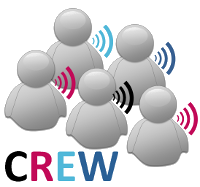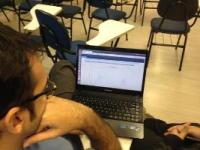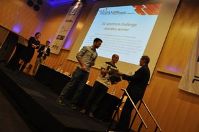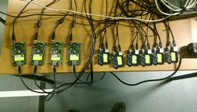FP7 CREW
Cognitive Radio Experimentation World
|
| |
| |
October 2015
|
Dear subscriber,
|
|
The FP7-CREW (Cognitive Research Experimentation World) project has ended after five years of successful operation with a great consortium. In this issue of the CREW newsletter, information is given about the upcoming final CREW event, the usage of CREW facilities for education, the 5G spectrum challenge at IEEE DySPAN 2015, an upcoming tutorial at Globecom 2015, the Social and Smart (Sands) project, a CREW-GENI experiment with Arizona State University and the future beyond CREW.
As this is the last newsletter of CREW in its current format, we take this opportunity to thank everyone who once was involved in this project. We were fortunate to work with so many great people in the consortium and in the different open calls.
|
CREW final public event
|
|
The CREW project has officially ended end of September 2015. For this reason a final public event is organised. The theme of the workshop is how open wireless experimental facilities can help to develop robust wireless solutions. This workshop will show what cognitive radio is, and showcase experiments on existing open test-beds. More information on the workshop and registration can be found here. Registration is free of charge for the FIRE community (please select the option "CREW / Fed4FIRE / FIRE partners and involved parties - 0 euro").
Go back to the top of the page.
|
Use of CREW facilities for education
|
|
Trinity College Dublin gave courses on Software Defined Radio physically at Universidade de Brasília, Brazil, Universidade Federal do Rio de Janeiro, Brazil, and Mexicali, Mexico. They are supported by experimentation conducted remotely on the TCD testbed that is part of CREW.
iMinds taught the various effects of Wi-Fi throughput to students at Ghent University (Belgium) using the iMinds Virtual Wall and w-iLab.t facilities. This lab is now being reused within other universities worldwide.
The development of these courses, using amongst others these CREW facilities, fit within the context of the FORGE project about combining e-learning with FIRE.
Go back to the top of the page.
|
IEEE DySPAN 2015 "5G spectrum sharing challenge" competition
|
|
A team led by researchers from Trinity College Dublin (TCD), Ireland, collaborating with Ilmenau University of Technology, Germany, won the title of "Objective Winner" in IEEE DySPAN 2015 5G Spectrum Challenge. The solution was designed and tested in the TCD testbed that is part of CREW project, and Ilmenau University of Technology was one of the CREW open call partners.
The team implemented a cognitive radio capable of avoiding interference with a very fast frequency hopping Zigbee-like Primary User (PU), by sensing and hopping to the empty channels in the spectrum. Their design focused on enabling simultaneous transmission of OFDM packets and spectrum sensing, as a way to achieve high throughputs and low reaction latencies in our radio when the PU moved to its channel. They also employed directive antennas to reduce the interference caused to the PU.
Go back to the top of the page.
|
Globecom 2015
|
|
On Thursday 10 December 2015, Luiz DaSilva (TCD), Mikolaj Chwalisz (TUB), Wei Liu (iMinds) and Adnan Bekan (JSI) will present "Hands-on experimentation with cognitive radio enabled systems" at Globecom 2015.
Tutorial abstract: Scarcity of spectrum is one of the factors limiting the increase of wireless access networks capacity. So, together with high interest in adopting new frequency bands, it is necessary that multiple networks will have to share large parts of the spectrum. Cognitive radio principle is a promising way to open the doors for such sharing. While the research in this area is very active, there is an acknowledged issue that the design and execution of real experiments remains very labor and cost intensive. Researchers and educators who are interested in experimentation with cognitive radio systems should have an understanding of: 1. How experiments with cognitive radio systems should be designed? 2. How to use the available testbed facilities? 3. What are the typical mistakes made while setting up cognitive radio experiments? The tutorial will address the above issues by set of presentations and hands-on exercises.
Go back to the top of the page.
|
Social & Smart (SandS) project
|
|
The Social & Smart (SandS) project investigates social housekeeping through intercommunicating appliances and shared recipes merged in a pervasive web-services infrastructure. Its goal is to build up a physical and computational networked infrastructure allowing household appliances to better meet the needs of their owners, by adding intelligence into the appliances. Recipes are the intelligence products of the social network. Thanks to its massive data feeding, the social network is enabled to sophisticatedly rule the appliances so as to maintain their software constantly updated to the currently best practice. A crucial component in the SandS architecture is the domestic infrastructure (DI), which translates recipes into board specific instructions.
Large stress tests were carried out in the iMinds testbed in Ghent, Belgium. To be able to execute the tests, extra hardware was installed in the testbed: 4 SandS motherboards and 6 Arduino Yun boards. The goal of experiments was to evaluate the performance of the DI’s communication manager when having a series of physical boards communicating over the Wi-Fi network. The experiments carried out were successful and show crucial links existing between particular SandS components and the hardware over which they run. The tests also resulted in an improved robustness of the solution, which could not be achieved by tests on a smaller scale.
Go back to the top of the page.
|
CREW-GENI experiment with Arizona State University
|
|
In the context of the collaboration of FIRE with NSF GENI, a collaboration between iMinds and the State Arizona has been initiated for using locating arrays for factor screening in a wireless network testbed. The purpose of a screening experiment is to identify significant configurable parameters in a wireless system and interactions between those parameters on a response (observable output variables) for a system. While screening using locating arrays have been successfully demonstrated in a simulation environment [1], the approach is now also validated in a real wireless tested (iMinds w-iLab.t2) and in a real-life scenario (Wi-Fi conferencing system with 1 speaker and 42 listeners). Such a system has 24 configurable parameters, leading to 5.59872×1012 parameter combinations. Thanks to the approach of locating arrays, the number of experiments can be limited to 109 parameter combinations.
[1] Abraham N. Aldaco, Charles J. Colbourn, Violet R. Syrotiuk: Locating Arrays: A New Experimental Design for Screening Complex Engineered Systems. ACM SIGOPS Operating Systems Review - Special Issue on Repeatability and Sharing of Experimental Artifacts, 49(1): 31-40 (2015)
Go back to the top of the page.
|
Beyond CREW
|
|
Although the CREW project is officially finished, we are happy to announce the sustained operation of the CREW facilities beyond CREW. Through a memorandum of understanding, all CREW partners have laid down their intention to make the CREW facilities and hardware further available for experimental validation of cognitive wireless solutions by external experimenters and provide free of charge basic support for scientific and/or experimental use at least for the coming 2 years.
We further would like to draw your attention to the WiSHFUL project that has started in 2015 and which involves several of the CREW testbeds (iMinds, TCS, TUB). The WiSHFUL project will organise funded open calls for experimentation and extensions. The first open Calls will be launched in December 2015. You can help to steer the open calls by filling out the questionnaire. More information on the WiSHFUL open calls can be found here.
Go back to the top of the page.
|
|
|
|
|




